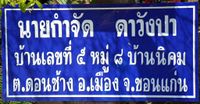Thailand/Naming and Addressing
| ⌂ Main | Projects | Naming and Addressing | Transportation | Places and Boundaries | Other Features | |||||||||||||||||||||||||||||||||||||||||||||||||||||||||||||||||||||||||||||||||||||||||||||||||||||||||||||||||||||||||||||||||||||||||||||||||||||||||||||||||||||||||||||
|
This page outlines the recommended practices for naming and addressing conventions in Thailand as used in OpenStreetMap (OSM). Because Thai is the official and most widely spoken language in the country, it plays a central role in tagging names and addresses. However, due to the country's linguistic diversity, presence of international signage, and common use of English in public infrastructure, multiple name tags and transliterations are often necessary. This guide provides detailed instructions on how to tag place names, street names, and addresses in both Thai script and Romanized forms, and offers guidance on transcription standards and numeral usage specific to the Thai context. Naming
Thai language is the primary and sole official language in Thailand, is undoubtedly the local language and should be used in In this section, we primarily refer to the following name tags: The maps Mapnik and Osmarender at OpenStreetMap.org use name=* e.g. the local names for rendering. There are maps available where the language can be chosen:
Place namestagged with Thai script as they are written on official sign, or by other reliable sources.
Road/Street/Soi names
Map Feature default namesIn general, feature names in Thailand used in the In general, feature names in Thailand used in the Numeral systemThai numerals (๐๑๒๓๔๕๖๗๘๙) are theoretically part of the Thai script writing system. Notably, they can be used interchangeably with Arabic numbers. Although Thai numbers are preferred in government documents, Arabic numbers are more commonly used in general writing. In general, Thai TranscriptionIn linguistics, romanization or latinization, also spelled as romanisation or latinisation (see spelling differences), refers to the representation of a written word or spoken speech using the Roman alphabet (Latin scripts) , or a system for doing so, where the original word or language uses a different writing system (or none). Methods of romanization include transliteration, which represents written text, and transcription, for representing the spoken word." [4] The Royal Thai General System of Transcription on Wikipedia (RTGS) is the official system for rendering Thai language words in the Latin alphabet, published by The Royal Society of Thailand on Wikipedia. It is used in road signs and government publications, and is the closest thing to a standard of transcription for Thai, though its use by even the government is inconsistent. [5][6] Getting the transcription:
AddressingIn Thailand addresses general consist of
References
|
||||||||||||||||||||||||||||||||||||||||||||||||||||||||||||||||||||||||||||||||||||||||||||||||||||||||||||||||||||||||||||||||||||||||||||||||||||||||||||||||||||||||||||||||||
